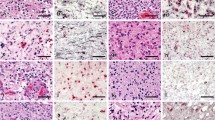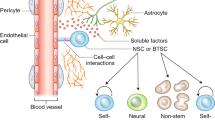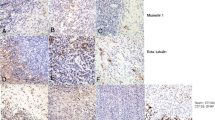Abstract
Tubulin beta II (Tub-II) is widely distributed in the developing neuronal axons and dendrites. Recent studies have demonstrated that Tub-II is also important in the early development of the human brain, and Tub-II represents a marker for progenitor and neural stem cells. To elucidate the correlation between the developing brain and neuroepithelial tumors (NETs), the present study assessed Tub-II expression by NETs and normal brain tissue using immunohistochemical and immunoblot analyses. In the gliomas, decreased numbers and staining intensities of Tub-II-positive cells tended to be associated with increased differentiation. Conversely, neuronal neoplasms displayed high percentages and strong staining intensities among the Tub-II-positive cells, irrespective of differentiation. In neuronal neoplasms and neoplasms with neuronal differentiation, Tub-II staining was far more intense and more homogeneous than Tub-II staining in gliomas. These results indicate that the expression of Tub-II in NETs may reflect architectural changes in the developing brain and may support the hypothesis that neuroepithelial tumors originate from glioneuronal progenitor cells capable of generating astrocytic, and neuronal cell types.




Similar content being viewed by others
References
Arai K, Shibutani M, Matsuda H (2002) Distribution of the class II beta-tubulin in developmental and adult rat tissues. Cell Motil Cytoskeleton 52:174–182
Banerjee A, Roach MC, Wall KA, Lopata MA, Cleveland DW, Luduena RF (1988) A monoclonal antibody against the type II isotype of beta-tubulin. Preparation of isotypically altered tubulin. J Biol Chem 263:3029–3034
Buc-Caron M-H (1995) Neuroepithelial progenitor cells explanted from human fetal brain proliferate and differentiate in vitro. Neurobiol Dis 2:37–47
Cavenee WK, Weller M, Furnari FB, Berens ME, Nagane M, Plate KH, Huang H-JS, Israel MA, Newcomb EW, Noble MD, Bigner DD, Kleihues P (2000) Diffusely infiltrating astrocytomas. In: Kleihues P, Cavenee WK (eds) Pathology and genetics of tumours of the nervous system. International Agency for Research on Cancer Press, Lyon, pp 10–21
Cleveland DW (1987) The multitubulin hypothesis revisited: what have we learned? Cell Biol 104:381–383
Cleveland DW, Lopata MA, MacDonald RJ, Cowan NJ, Rutter WJ, Kirschner MW (1980) Number and evolutionary conservation of alpha- and beta-tubulin and cytoplasmic beta- and gamma-actin genes using specific cloned cDNA probes. Cell 20:95–105
Cudkowicz M, De la Monte SM (1989) Histogenesis and cell lineage analysis of medulloblastomas. J Neurol Sci 94:221–229
Giangaspero F, Cenacchi G, Losi L, Cerasoli S, Bisceglia M, Burger PC (1997) Extraventricular neoplasms with neurocytoma features. A clinicopathological study of 11 cases. Am J Surg Pathol 21:206–212
Kanemura Y, Mori K, Sakakibara S, Fujikawa H, Hayashi H, Nakano A, Matsumoto T, Tamura K, Imai I, Ohnishi T, Fushiki S, Nakamura Y, Yamasaki M, Okano H, Arita N (2001) Musashi1, an evolutionarily conserved neural RNA-binding protein, is a versatile marker of human glioma cells in determining their cellular origin, malignancy, and proliferative activity. Differentiation 68:141–152
Katsetos CD, Valle LD, Geddes JF, Assimakopoulou M, Legido A, Boyd JC, Brian B, Parikh NA, Maraziotis T, Chadarevian J-P de, Varakis JN, Matsas R, Spano A, Frankfurter A, Herman MM, Khalili K (2001) Aberrant localization of the neuronal class III β-tublin in astrocytomas. A maker for anaplastic potential. Arch Pathol Lab Med 125:613–624.
Keyoung HM, Roy NS, Benraiss A, Louissaint A Jr, Suzuki A, Hashimoto K, Rashbaum WK, Okano H, Goldman SA (2001) High-yield selection and extraction of two promoter-defined phenotypes of neural stem cells from the fetal human brain. Nat Biotech 19:843–850
Komori T, Scheithauer BW, Anthony DC, Rosenblum MK, Mclendon RE, Scott RM, Okazaki H, Kobayashi M (1998) Papillary glioneuronal tumor. A new variant of mixed neuro-glial neoplasm. Am J Surg Pathol 22:1171–1183
Kukekov VG, Laywell ED, Suslov O, Davies K, Scheffler B, Thomas LB, O’Brien TF, Kusakabe M, Steindler DA (1999) Multipotent stem/progenitor cells with similar properties arise from two neurogenic regions of adult human brain. Exp Neurol 156:333–344
McKay R (1997) Stem cells in the central nervous system. Science 276:66–71
Nakamura Y, Becker LE (1983) Subependymal giant-cell tumor: astrocytic or neuronal? Acta Neuropathol (Berl) 60: 271–277
Nakamura, Y, Yamamoto M, OdaE, Yamamoto A Kanemura Y, Hara M, Suzuki A, Yamasaki M, Okano H (2003) Expression of tubulin beta II in neural stem/progenitor cells and radial fibers during human fetal brain development. Lab Invest 83:479–489
Nishiyama A, Chang A, Trapp BD (1999) NG2+ glial cells: a novel glial cell population in the adult brain. J Neuropathol Exp Neurol 58:1113–1124
Palmer JO, Kasselberg AG, Netsky MG (1981) Differentiation of medulloblastoma studies including immunohistochemical localization of glial fibrillary acidic protein. J Neurosurg 55:161–169
Perry A, Scheithauer BW, Macaulay RJB, Raffel C, Roth KA, Kros JM (2002) Oligodendrogliomas with neurocytic differentiation. A report of 4 cases with diagnostic and histogenetic implications. J Neuropathol Exp Neurol 61:947–955
Pincus DW, Keyoung HM, Harrison-Restelli C, Goodman RR, Fraser RAR, Edgar M, Sakakibara S, Okano H, Nedergaard M, Goldman SA (1997) Fibroblast growth factor-2/brain-derived neurotrophic factor-associated maturation of new neurons generated from adult human subependymal cells. Ann Neurol 43:576–585
Roy NS, Wang S, Jiang L, Kang J, Benraiss A, Harrison-Restelli C, Fraser RAR, Couldwell WT, Kawaguchi A, Okano H, Nedergaard M, Goldman SA (2000) In vitro neurogenesis by progenitor cells isolated from the adult human hippocampus. Nat Med 6:271–277
Sakakibara S, Imai T, Hamaguchi K, Okabe M, Aruga J, Nakajima K, Yasutomi D, Nagata T, Kurihara Y, Uesugi S, Miyata T, Ogawa M, Mikoshiba K, Okano H (1996) Mouse-Musashi-1, a neural RNA-binding protein highly enriched in the mammalian CNS stem cell. Dev Biol 176:230–242
Sakakibara S, Okano H (1997) Expression of neural RNA-binding proteins in the post-natal CNS: implication of their roles in neural and glial cells development. J Neurosci 17:8300–8312
Sanai N, Tramontin A, Quinones-Hinojosa A, Barbaro NM, Gupta N, Kunwar S, Lawton MT, McDermott MW, Parsa AT, Verdugo J M-G, Berger MS, Alvarez-Buylla A (2004) Unique astrocyte ribbon in adult human brain contains neural stem cells but lacks chain migration. Nature 427:740–744
Shoshan Y, Nishiyama A, Chang A, Mork S, Barnett GH, Cowell JK, Trapp BD, Staugaitis SM (1999) Expression of oligodendrocyte progenitor cell antigen by gliomas: implications for the histogenesis of brain tumors. Proc Natl Acad Sci USA 96:10361–10366
Singh SK, Hawkins C, Clarke ID, Squire JA, Bayani J, Hide T, Henkelman RM, Cusimano MD, Dirks PB (2004) Identification of human brain tumour initiating cells. Nature 432:396–401
Sugita Y, Yamada S, Sugita S, Morimatsu M, Shigemori M (2001) Analysis of neurotransmitters in central neurocytomas. Int J Mol Med 7:521–525
Sullivan KF (1988) Structure and utilization of tubulin isotypes. Annu Rev Cell Biol 4:687–716
Sullivan KF, Cleveland DW (1986) Identification of conserved isotype-defining variable region sequences for four vertebrate beta-tubulin polypeptide classes. Proc Natl Acad Sci USA 83:4327–4331
Teo JGC, Gultekin SH, Bilsky M, Gutin P, Rosenblum MK (1999 ) A distinctive glioneuronal tumor of the adult cerebrum with neuropil-like (including “rosetted”) islands. Am J Surg Pathol 23:502–510
Tohyama T, Lee VM-Y, Rorke LB, Marvin M, McKay RDG, Trojanowski JQ (1992 ) Nestin expression in embryonic human neuroepithelial and in human neuroepithelial tumor cells. Lab Invest 66:303–313
Valtz NLM, Hayes TE, Norregaard T, Liu S, McKay RDG (1991) An embryonic origin for medulloblastoma. New Biologist 3:364–371
Author information
Authors and Affiliations
Corresponding author
Rights and permissions
About this article
Cite this article
Sugita, Y., Nakamura, Y., Yamamoto, M. et al. Expression of tubulin beta II in neuroepithelial tumors: reflection of architectural changes in the developing human brain. Acta Neuropathol 110, 127–134 (2005). https://doi.org/10.1007/s00401-005-1022-8
Received:
Revised:
Accepted:
Published:
Issue Date:
DOI: https://doi.org/10.1007/s00401-005-1022-8




